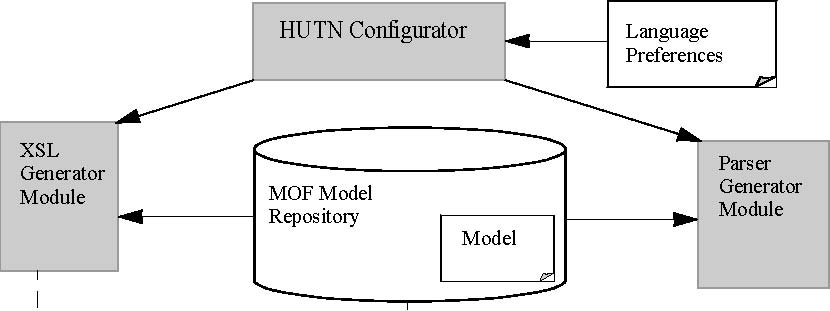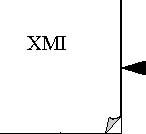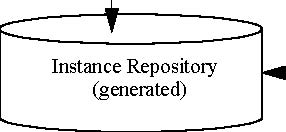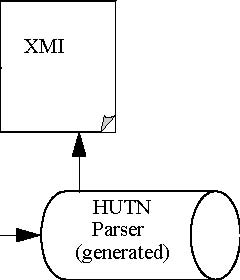
| Previous | Table of Contents | Next |
DSTC Pty Ltd is currently engaged in a 7 year research program into Enterprise Distributed Systems Technology with major projects
devoted to enterprise modeling and the mapping of such models into middleware technology. DSTC Pty Ltd has extensive experience
in the standardization, implementation, and use of MOF and XMI. The DSTC has had a prototype implementation since 1999 based
on XSLT [XSLT99] and Antlr [Antlr] (earlier versions used [JavaCC]) that has been used internally in developing prototypes
for other DSTC RFP Responses, and for enterprise-oriented research projects. The tool is also available for download and evaluation
from http://www.dstc.edu.au/Research/Projects/Pegamento/TokTok/index.html.
The original design of the system is illustrated in Figure 1-1 with the components to be
implemented as part of the HUTN system shaded.
The MOF Model Repository is a repository for information models, which are created in a custom model definition language (called
the Meta-Object Definition Language or MODL). DSTC’s MOF product is used for this purpose, since it has the advantage of being
able to generate fully functional instance repositories from the model in the Model repository. The XMI subsystem performs
the role of generating programs (and a DTD) for transferring data between the instance repository and XMI form.
Although the original design was quite symmetric and elegant, it was found to be easier in practice to parse directly into
the instance repository rather than into XMI format. However, the original design is technically feasible.

XMI




Textual Notation (HUTN)
Figure 1-1 Original Structure of the DSTC HUTN System
1-2 Human-Usable Textual Notation, v1.0 August 2004
The system is divided into three basic components. The XSL generator component is responsible for the creation of an XSLT
style sheet for converting a stream of XMI into the target human-usable language. The Grammar Generator component generates
an ANTLR grammar and associated backend code for the parsing of the language back into a MOF-compliant repository. Finally,
the so-called Configurator component is responsible for parsing a file containing the language configurations for the shorthands,
and for communicating these preferences to the two generator components.
The Grammar Generator and the XSL Generator components are designed around a common generator architecture, which provides
a simple mechanism for communicating with the MOF. The architecture is enacted through the use of an existing Java package
included as part of the DSTC’s MOF system.
The HUTN modules were implemented in the Java programming language. Java provides a number of features that make it a useful
language for this purpose, such as its mature object orientation and use of interfaces, and its ready connectivity with CORBA.
The CORBA product used for this implementation was Inprise’s “Visibroker for Java? [Visibroker] product. This was chosen because
it is the system used in the dMOF product, and was thus less likely to induce compatibility problems.
France Telecom has developed since 1997 a MOF-based model repository tool [Belaunde99] and has implemented since 1999 facilities
to import and export textual human usable specifications that use a Java-like syntax (the notation was originally named JMI)
and a hierarchical identification system. The implementation uses a generic parser that is connected at run-time to the API’s
generated from the MOF-compliant metamodel definitions (no intermediate BNF parser generation is used). France Telecom has
provided feedback to the other submitters based on its original implementation.